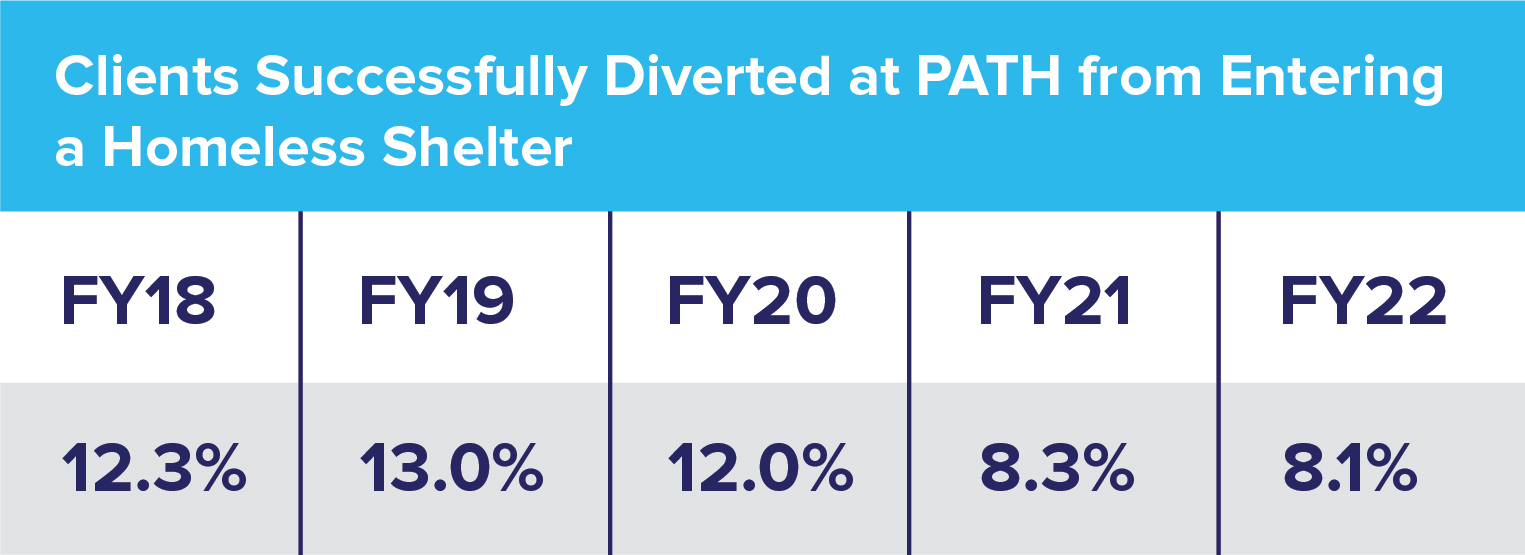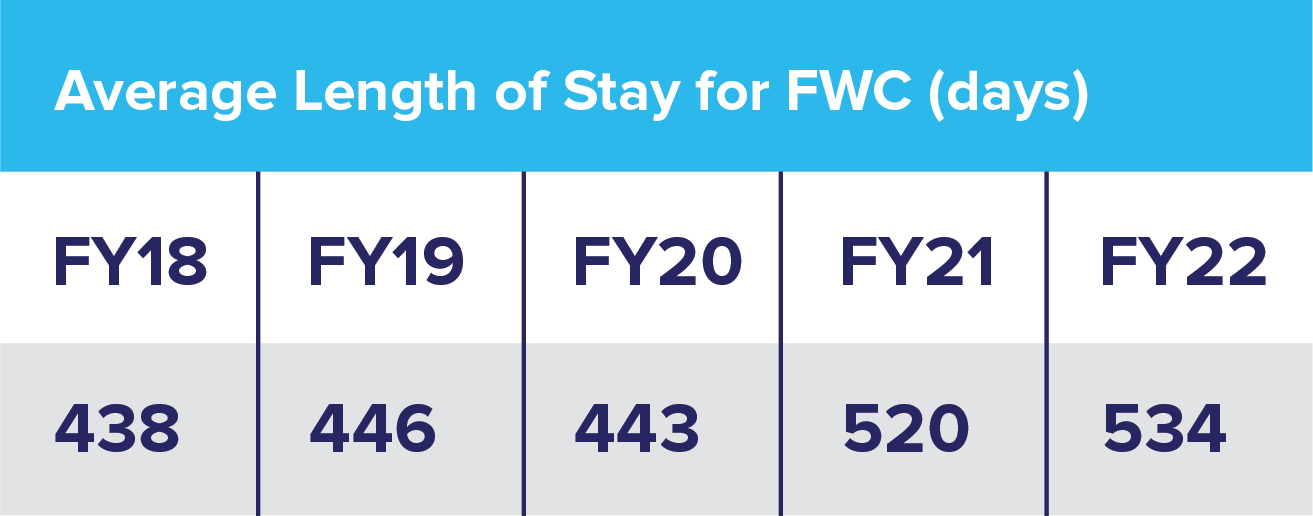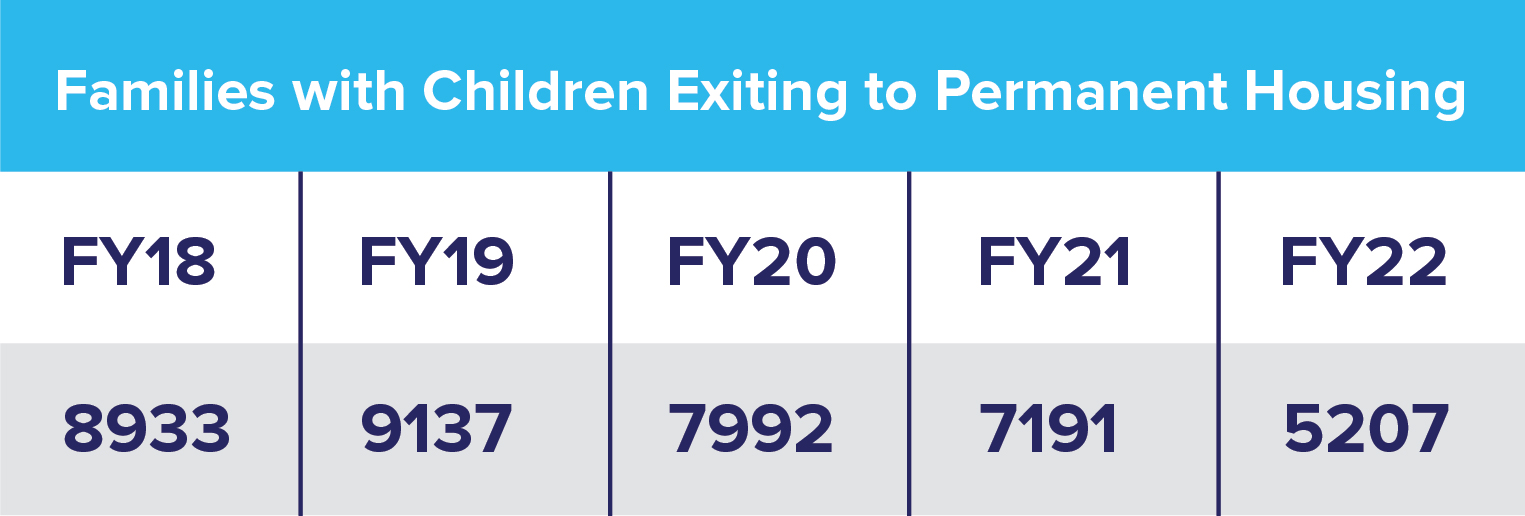By Caroline Iosso, Senior Policy Associate, Homes for the Homeless (HFH)
Recently, Mayor Eric Adams’ administration released the updated Mayor’s Management Report, or MMR, for fiscal year 2022 (July 1, 2021 – June 30, 2022). While the new Dynamic MMR is updated throughout the year with new data for certain indicators, the September publishing of the MMR is a comprehensive look at how the City served its constituents for the last fiscal year.i
During the latest fiscal year, the results for homeless families are largely a continuation of discouraging trends. Families with children are staying in shelter longer and fewer are moving out into permanent housing. The rate of families being diverted from entering shelter is the lowest it’s been in the last five years.
First, here’s a look at how these numbers break down for families with children living in shelter and attempting to leave shelter over the last five years.
- The average length of stay in DHS shelters is approximately 1.5 years for families with children.
- The average length of stay increased by 2.7% from FY21, which is a decrease in the rate of increase from FY20–21, which was 17.4%. While it is good news that the rate of increase is lower, the number of months families are in shelter on average is still far too high. It underscores how difficult it is to find and secure affordable housing and raises the alarm about the unnecessary red tape of DHS bureaucracy that keeps families in shelter longer.
- The average length of stay has increased by 22% over the last five fiscal years since FY18.
- One critical way to decrease the number of months families spend in shelter is to ensure families are not trapped in the limbo of conditional status as they seek eligibility for shelter. As our recent report, Long and Winding PATH: The Burden of Repeated Shelter Eligibility Denials on Families and Shelter Providers, shows, families are in conditional status for far longer than the supposed 10-day investigative period. While in conditional status, applying and reapplying for shelter eligibility, families cannot access critical housing subsidies that could help them move out of shelter, such as CityFHEPS. Furthermore, CityFHEPS and other vouchers require a 90-day stay as an eligible client in order to qualify for the voucher; the dozens of days to months spent in conditional status do not count. This means that it is taking clients even longer to be able to move into permanent housing.
- The number of families with children exiting to permanent housing has decreased by 27.6% from FY21 to FY22.
- While continuing COVID restrictions on viewing apartments may account for some of this decrease, the MMR also notes that NYCHA apartment availabilities have been greatly reduced.
- The rate of decrease from FY20–FY21 was 10%; this year’s decrease was more than twice as sharp.
- The number of FWC exiting to permanent housing has decreased by 42% over the last five fiscal years since FY18.
- This decrease reflects the toll that increasing rents all over the City, stalling housing construction, and rampant discrimination against voucher holders have taken on low-income families seeking housing. Families are facing a tight housing market and struggle to find housing they can afford. Once they find this housing, they may be unable to apply for it or move in due to brokers’ and landlords’ illegal prejudices against the housing subsidy the family may be using to help pay their rent.Seeing this number continue to decline—and to decline by over double the rate as the previous year—should demonstrate to the administration that action must be taken to make housing more available to families in shelter. The City should prioritize helping families stabilize their lives so that moving into housing is attainable. Service-rich shelters that offer employment navigation, job training programs, comprehensive case management, and support with applying for and securing housing help families to do just that; the Administration must make sure all families have access to quality shelters.
We’re also seeing troubling new trends as families enter shelter. As ICPH has been tracking weekly, the DHS shelter census has been steadily, and more recently sharply, increasing over the last year. The metrics available in the MMR flesh out this crisis even further.

- The percent of families who are able to access resources at PATH that keep them from entering the shelter system is the lowest it has been in five years.
- This data point shows us that for an increasing number of families, shelter is the only option available. One-shot deals or other prevention assistance cannot help them stave off a shelter stay.
- As fewer and fewer families are able to secure other resources to stabilize their housing situations, the number of families in shelter will continue to increase.
In the last fiscal year, the Human Resource Administration’s Office of Civil Justice doubled the number of households served by the City’s Universal Access to Counsel (“Right to Counsel”) Law. 28,730 households facing eviction in court received legal assistance, doubling the number served in FY 2021.
- The Right to Counsel—the first law of its kind in the nation—is a critical tool in driving down the incidences of family homelessness, as it helps families defend themselves against eviction and, in many cases, maintain their tenancies. According to the MMR, more families are in need of this type of assistance with the end of the pandemic-era eviction moratorium and subsequent increase in eviction filings. However, there are deficits in the number of lawyers who can take on these cases.ii This high need and low supply of lawyers who can support families may contribute to even greater increases in the family census in the coming months.
The portrait painted by the MMR is of a homelessness ecosystem where more and more families are at risk of eviction and entering shelter, while families in shelter are staying in them longer and finding it more difficult to move into permanent housing. The need for concrete solutions is urgent. When families experience homelessness, they need access to service-rich shelters that provide the stability and support required to get back on their feet. This assistance coupled with easier access to housing subsidies, elimination of the red tape that keeps families in shelter longer, eradication of illegal housing discrimination, and increased affordable housing availabilities for families will lead to the indicators moving in the right direction for an increasing number of New Yorkers.
i It is important to note that during the summer of 2022, the family homelessness census increased significantly. This sharp increase creates a larger-than-usual disconnect between what families in shelter are experiencing now versus over the past fiscal year and warrants an immediate update to MMR data.
ii https://www.cityandstateny.com/policy/2022/09/evictions-slowly-ramp-after-covid-19/377288/

